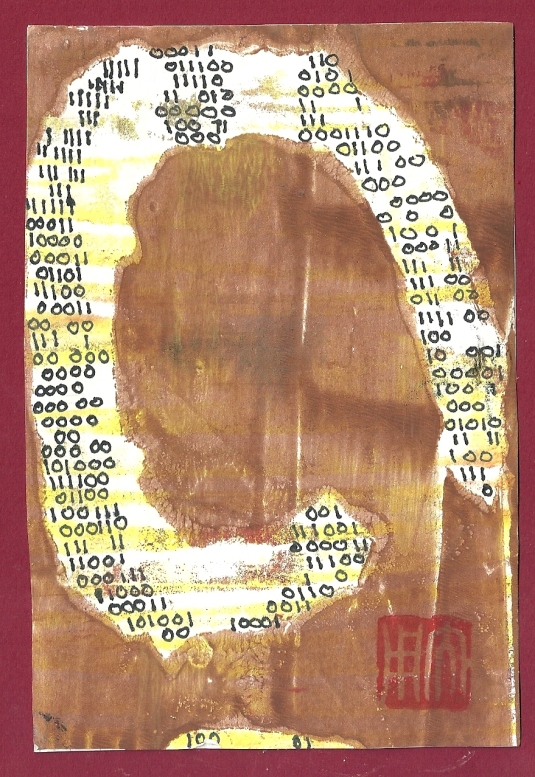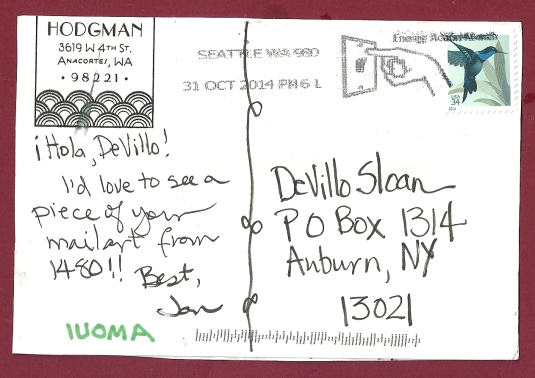Mail-art by IUOMA member Jan Hodgman (Anacortes, Washington, USA)
November 10, 2014 - I am assuming this beautiful postcard-size work by Jan Hodgman is asemic-vispo. She is a thoughtful and interested member of the asemic writing group at the IUOMA. Her inclusion of a binary system (one and zero) immediately caught my eye. (There is also a larger glyph present.)
The asemic syntax book project that some members participated in was directly related to this interest in structures beyond individual symbols. It was interesting how some of the artists believed syntax could not exist independent of meaning. In fact, I once had a very interesting discussion with Guido Vermeulen about the relationship of codes to asemic writing. Guido was very interested in the idea. The consensus was, if I recall, that a code that can be “cracked” is not asemic. Something that appears to be a code or uses elements of a code but is ultimately incomprehensible is asemic.
I greatly appreciate this work from Jan Hodgman (1) because it is such a beautiful piece of mail-art and (2) because it compels me to meditate upon the nature of language. I doubt I will be able to find any old work from 1480 AD, but I will be sure to send something in reply.
Comment
-
Comment by De Villo Sloan on November 10, 2014 at 10:21pm
-
If you're ever inclined, dig into the book project sections of the asemic writing group. The asemic syntax book project was interesting. I'll see if I can find any of the books.
Well, trying to explain the stuff feels like struggling in quicksand.
-
Comment by Rebecca Guyver on November 10, 2014 at 8:02pm
-
I wasn't present, but I wish I'd been! thanks for taking the time to explain it. And to think there are people who run out of things to do or think about!
-
Comment by De Villo Sloan on November 10, 2014 at 7:57pm
-
Right, Rebecca. I think you get the idea. I don't know if you were present for the code discussion with Guido Vermeulen or the "asemic syntax" book project with Cheryl Penn. Asemic writing discussions can become very abstract. You can find examples online. The asemic syntax books raised a lot of related discussion at the IUOMA.
In short, using the purist definition, asemic writing cannot be read in a conventional way but it must suggest a language. It can be expressive and thus can be "read" in unconventional ways. Kerri Pullo's work is a great example because it is so expressive.
So you can invent an imaginary language that is asemic. People do that all the time. But if you codify the language with lexicons, codes, etc., then it's technically not asemic. So you can have an imaginary language that is not asemic. Otherwise, if you follow the faulty logic, Japanese would be asemic to anyone who did not know Japanese.
Jan started all this with her allusion to a binary system.
Guido challenged Cheryl and me at first because he didn't think asemic syntax was possible. But we got it around to a place where we all understood what we were taking about and agreed it could be done. JMB proved it with a bunch of stones and sticks laid out in a repeating pattern.
Actually, Noam Chomsky's "deep structure" linguistics (few people now remember he started out as a brilliant linguist) could provide models for constructing asemic syntax, as he charted the abstract patterns upon which meaning is built and communicated.
Asemics can be very simple, but there is definitely another track that is connected to language theory and philosophy. It's no wonder that so many pomo types are attracted to it.
-
Comment by Rebecca Guyver on November 10, 2014 at 4:53pm
-
Gorgeous! And great to understand the distinction about code cracking. I was working with kids last week and we made what I called 'spy notebooks' and they created languages, making codes. I made the 'language of metal' as an example, where I found characters in metal objects. They made some beautiful pieces out of their own alphabets. A few of the children didn't understand the concept at first and made asemic pieces for sure. I wish I'd photographed them...
© 2025 Created by Ruud Janssen.
Powered by
![]()


You need to be a member of International Union of Mail-Artists to add comments!
Join International Union of Mail-Artists